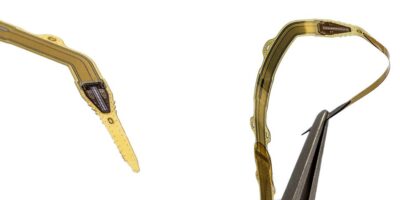Imec unveils thin-silicon implantable chip for high-precision haptic prosthetics
Research and innovation hub for nano-electronics and digital technology, imec, has announced it has successfully fabricated a prototype implantable chip that aims to give patients more intuitive control over their arm prosthetics.
The thin-silicon chip is believed to be a world’s first for electrode density and was developed in collaboration with researchers at the University of Florida, as part of the IMPRESS (Implantable Multimodal Peripheral Recording and Stimulation System) project, funded by the Defense Advanced Research Project Agency (DARPA)’s HAPTIX (Hand Proprioception and Touch Interfaces) program to create a closed-loop system for future-generation haptic prosthetics technology.
Today, arm prosthetics technologies give patients the ability to move their artificial arm and hand to grasp and manipulate objects by reading signals from the person’s muscles or peripheral nerves to control electromotors in the prosthesis, to convey intent. These prosthetics however, still do not allow a fine motor control and do not give patients a feeling of touch. Prosthetics under development will provide amputees with rich sensory content from these artificial limbs by delivering precise electrical patterns to the person’s peripheral nerves using implanted electrode interfaces. According to Rizwan Bashirullah, associate professor of Electrical and Computer Engineering, and director of the University of Florida’s IMPRESS program, “this effort aims to create such new peripheral nerve interfaces with greater channel count, electrode density, and information stability, enabled largely by imec’s technological innovation.”
As part of IMPRESS, imec has now made a prototype ultra-thin (35µm) chip with a bio-compatible, hermetic and flexible packaging. On its surface are 64 electrodes, with a possible extension to 128. This high amount of electrodes allows fine-grained stimulation and recording, says imec. Through a needle attached to the chip, the package can be inserted and attached inside a nerve bundle, further increasing the precision of reading and stimulation compared to current technology. At present there are substantially fewer electrodes which are wrapped around the nerve bundle. In practice, imec’s solution will give patients more control over their prosthetic arm and hand, and also the possibility of a finer haptic feedback.
“A new biocompatible chip encapsulation technology is used, based on the stacking of nanolayers with superior diffusion barrier properties, alternating with very thin polymer layers with excellent mechanical behaviour,” explains Maaike Op de Beeck, program manager at imec. “The final result is an ultra-thin, flexible electronic device with a thickness comparable to that of a human hair, hence ultimately suitable for minimal invasive implantation.”
This work was sponsored by the DARPA’s Biological Technologies Office under the auspices of Dr. Doug Weber through the Space and Naval Warfare Systems Center, Pacific Grant/Contract No. N66001-15-C-4018 to the University of Florida.
WEARTECHDESIGN.COM – Latest News/Advice on Technology for Wearable Devices
Weartechdesign is unlike any other website currently serving the technology
for wearable devices. We carry the very latest news for design engineers and purchasers.
Register on our mailing list to receive regular updates and offers from
WearTechDesign




